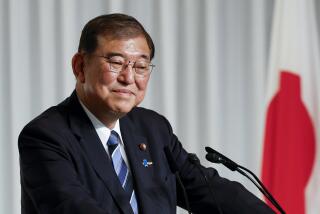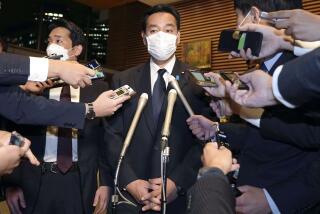The buzz on Japan’s new premier: too old-school
TOKYO — Political honeymoons end sooner or later for almost every leader, but the danger for new Japanese Prime Minster Shinzo Abe is not just that his popularity is sliding three months into the job. It’s that he’s already being mocked.
Consider the view of Brutus magazine, a style bible for Tokyo men who care about being ahead of every trend, whether it’s fad food or how to look cool at the gym. “Beautiful Country?” asked the cover of the magazine’s December edition, invoking the political mantra Abe has used to sell his nationalist vision of a resurgent Japan.
Out of touch, Brutus scolded Abe.
“Right now what the entire world is crazy about is cool Japan,” the magazine cover line told Abe, referring to the elements of Japanese culture, from anime to architecture, that are now part of global chic.
The Brutus view sums up a developing perception here: that Japan’s youngest postwar prime minister may be an out-of-touch young fogey, more nostalgic for an old Japan than eager to usher in a new one.
Critics contend that his government’s focus on nationalist obsessions such as passing laws to enforce patriotism among schoolchildren is a distraction from the core economic and social issues that present far graver challenges to Japan.
They also argue that Abe’s government lacks discipline and coherence. Since North Korea’s nuclear weapons test Oct. 9, some senior government officials have repeatedly called for a debate on whether Japan needs its own nuclear option, in defiance of Abe’s desire to shut down the chatter.
Suspicions that Abe lacks toughness -- and control over his party -- are contributing to his sudden slip in polls. A Jiji Press poll in mid-December put Abe’s approval rating at 42%, a 9-percentage-point fall in a month.
He had been off to a positive start. Within days of taking office, Abe held summit meetings with the leaders of China and South Korea, ending the top-level diplomatic freeze sparked by the visits of his predecessor, Junichiro Koizumi, to Yasukuni Shrine, where Japanese war criminals are among the honored souls of the country’s war dead.
But the prime minister has stumbled on the domestic front. Despite the markets’ buzz about the long-last arrival of a Japanese recovery, the economy has yet to truly catch fire, largely because domestic consumption remains sluggish.
That hurts Abe, who is counting on consumer-led growth to help resolve Japan’s massive public debt. The prime minister is eager to avoid any high-profile tax hikes ahead of crucial Upper House elections in July, which are being seen as a referendum on his leadership.
That leaves little room to maneuver. Abe is committed to continuing Koizumi’s belt-tightening reforms that have cut public spending, notably transfers of cash to the towns and regions that form the Liberal Democratic Party base.
Koizumi used his populist skills to free himself from the calcified hand of the political machine that has ruled postwar Japan from its backrooms. His ability to build a public consensus for his policies gave him an independence that allowed him to hack away at the party’s habit of showering its supportive constituencies with public money.
Koizumi was even able to chase the hard core of anti-reformers out of the party by successfully calling a death-or-glory election in which he ran his own reformist candidates against LDP “rebels” who opposed a key economic reform.
But Abe shocked many here by welcoming that old guard back into the party this fall. The move made him appear beholden to the LDP’s old back-room chieftains and seem deaf to voters’ call for a more modern approach to politics.
“When Abe brought the rebels back into the party, people got the impression he was retreating from the reform agenda,” political analyst Takao Toshikawa said.
Even Abe’s 2007 budget shows how he is being pulled between imperatives to slash the size of government and the political need to satisfy politicians clamoring for public funds.
Abe billed his first budget as a cost-cutting exercise that would eliminate annual budget deficits by 2011 or earlier, pledging to cut the number of bonds issued by 15.2% and lowering spending on public works projects by 3.5%.
Even so, rising welfare and medical costs associated with Japan’s rapidly aging population meant the budget’s overall spending rose by 4%. And in its less-noted supplemental budget for 2006, the Abe government chose to spend much of the $38.6-billion windfall from higher-than-expected tax revenue on public works projects, although some were labeled “disaster prevention programs.”
“Koizumi reduced spending on public works and cut the allocation of taxes to local governments, but with local economies weakening, there has been mounting pressure within the LDP to restore some of the old subsidies,” said Hiromichi Shirakawa, chief economist at Credit Suisse in Tokyo. “These extra tax revenues were funneled back into what you could call ‘old Japan.’ ”
Hisako Ueno of The Times’ Tokyo Bureau contributed to this report.
More to Read
Sign up for Essential California
The most important California stories and recommendations in your inbox every morning.
You may occasionally receive promotional content from the Los Angeles Times.










